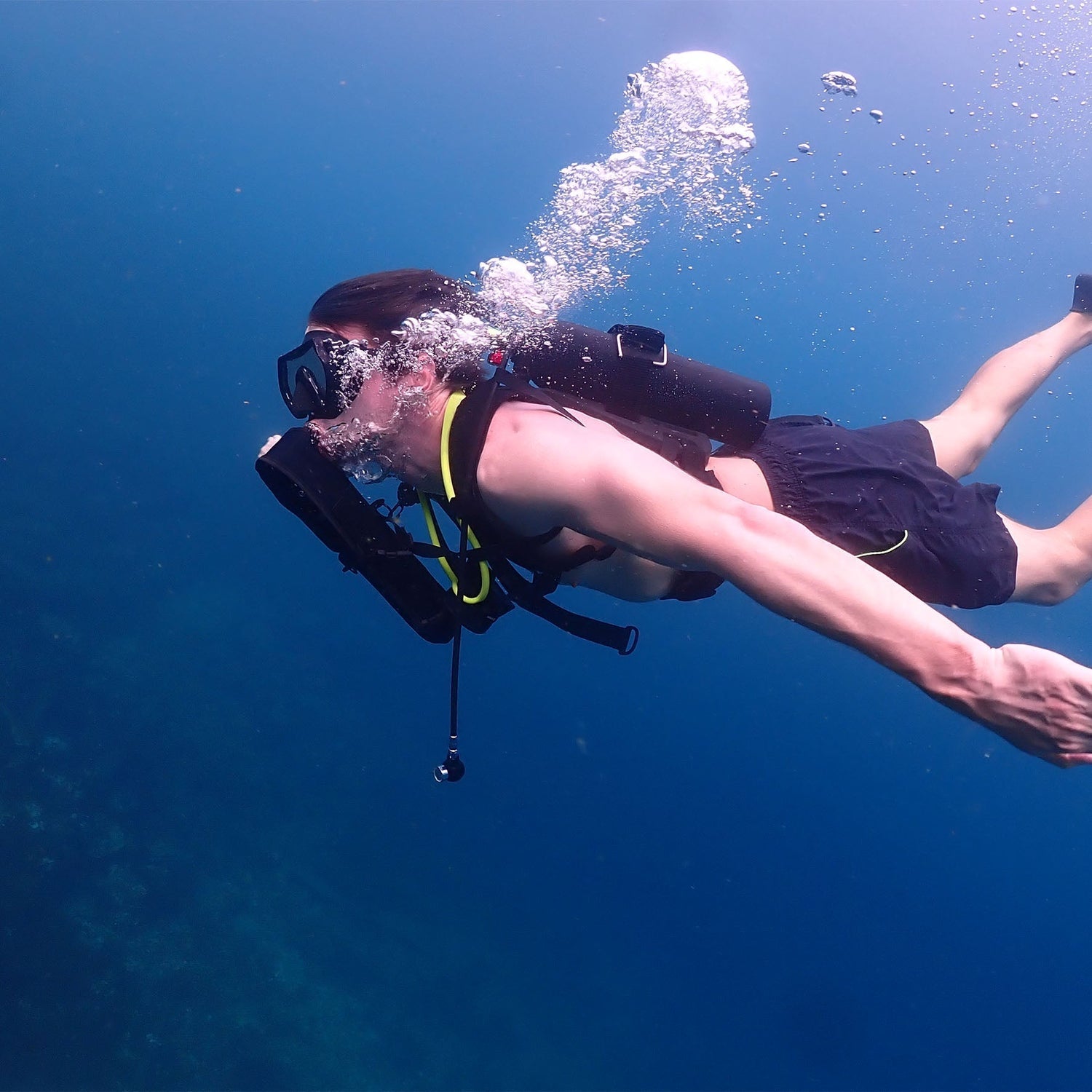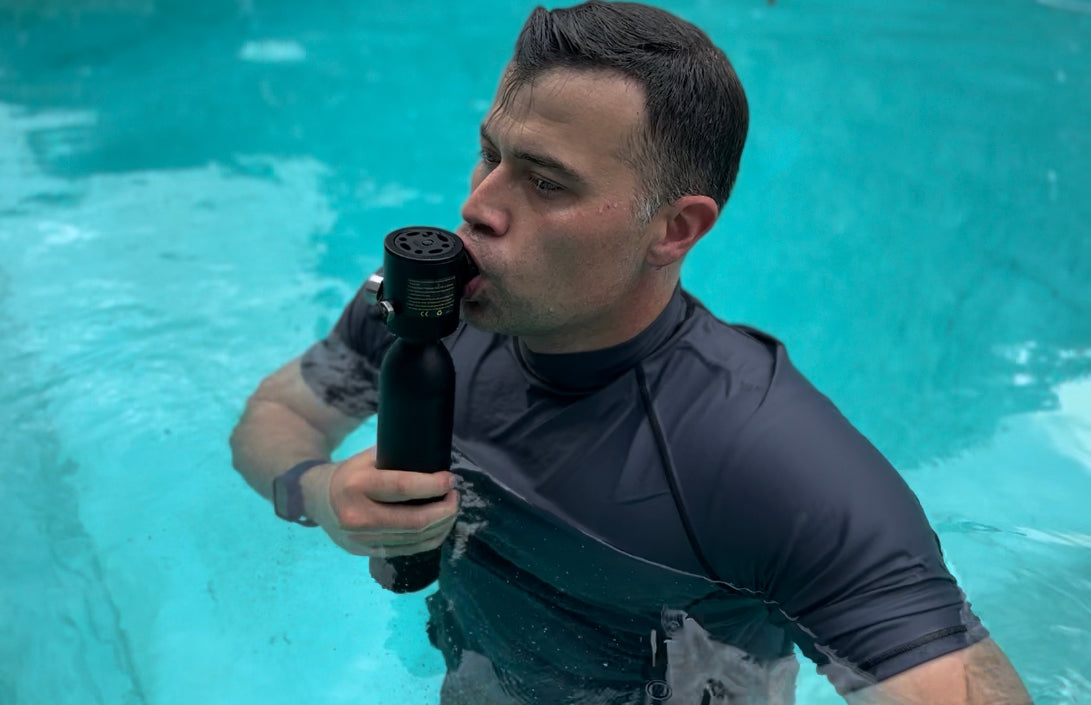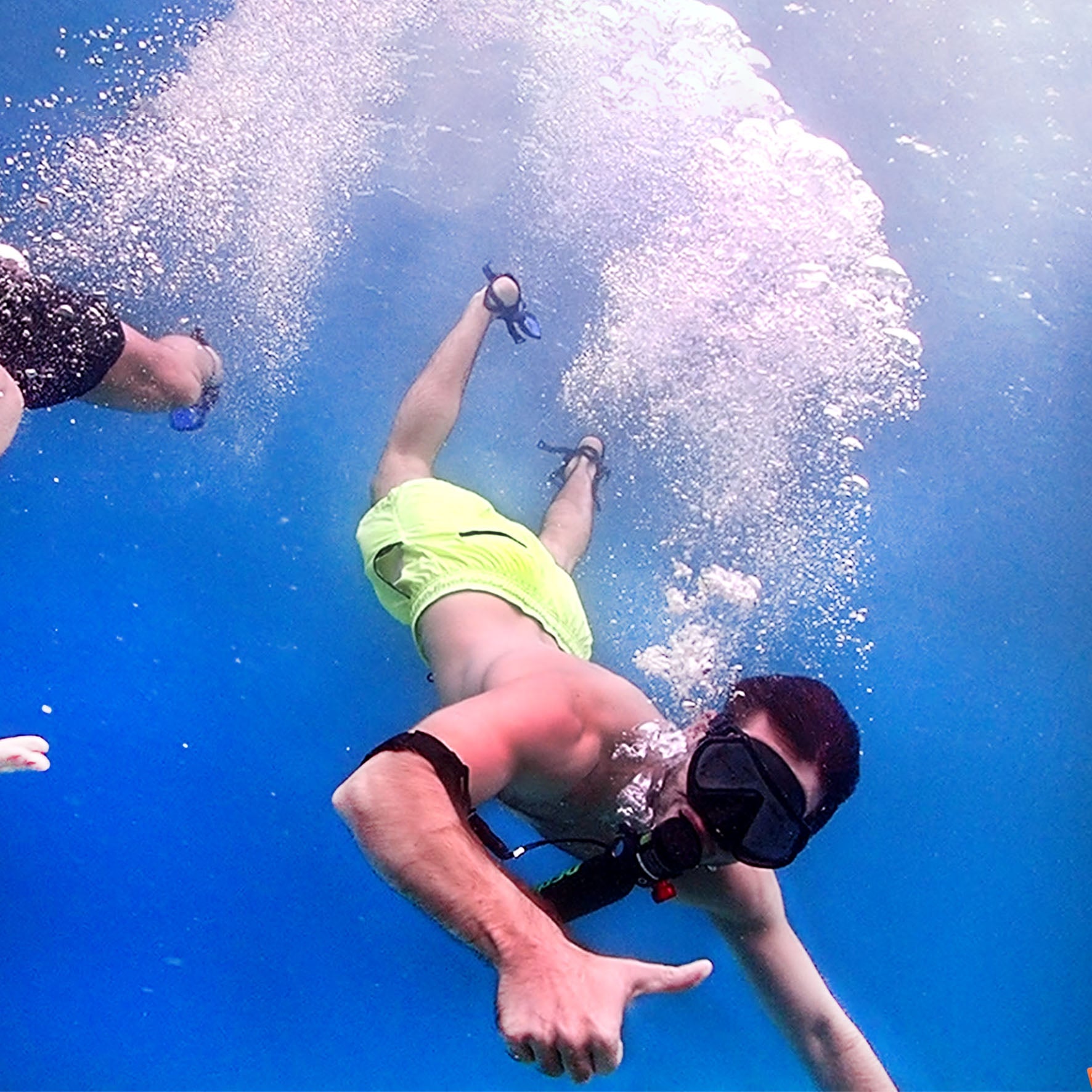Most people assume scuba tanks are filled with pure oxygen, but standard diving tanks actually contain just 21% oxygen—the same as regular air. Using 100% oxygen underwater is dangerous beyond 6 meters (20 feet) due to oxygen toxicity, which can cause seizures. Recreational divers typically use normal air or enriched air nitrox (22-40% oxygen) for longer bottom times. Technical divers may use trimix (oxygen, nitrogen, and helium) for deep dives below 40 meters (130 feet).
What’s Really Inside a Scuba Tank
Most people think scuba tanks are filled with pure oxygen, but standard recreational tanks actually hold regular air—21% oxygen and 79% nitrogen, compressed to 200-300 bar (2,900-4,350 psi). Pure oxygen is rarely used because it becomes toxic below 6 meters (20 feet), risking seizures. Instead, divers use:
Normal air (21% O₂): The cheapest option, costing 5-10 per fill, good for dives up to 40 meters (130 feet).
Nitrox (22-40% O₂): Extends bottom time by reducing nitrogen absorption—e.g., EAN32 (32% O₂) allows ~20% longer dives at 18-30 meters (60-100 feet). Fills cost 10-20, needing special filters to remove moisture.
Trimix (oxygen + nitrogen + helium): Used below 40 meters (130 feet) to prevent narcosis. A typical mix like 18/45 (18% O₂, 45% helium) cuts nitrogen load by 30-50% but costs 50-100 per fill due to helium prices (~0.80-1.20 per liter).
Tank sizes vary:
Aluminum 80 (11L, 207 bar): Weighs 14 kg (31 lbs), holds 2,400L of air, lasts 45-60 mins at 10m.
Steel 12L (232 bar): Holds 2,800L, lasts ~70 mins, but weighs 18 kg (40 lbs).
Key rule: Never use 100% O₂ below 6m—even 40% Nitrox has a max depth of 30m (100 ft) before toxicity risks spike.
1. Standard Air: Cheap, Simple, and Limited
Recreational divers breathe the same air as on land—just compressed. At 200 bar, an 11L tank stores ~2,400L of air, enough for 45-60 mins at 10 meters (33 ft). Deeper dives (e.g., 30m/100ft) cut time to 20-25 mins due to 3x higher air consumption. Cost: 5-10 per fill, with filters removing 99.9% of oil/water.
2. Nitrox: Pay More, Dive Longer
Enriched air (EAN32 or EAN36) reduces nitrogen intake, letting divers stay down 15-30% longer. For example:
At 18m (60ft), no-deco time jumps from 55 mins (air) to 75 mins (EAN32).
O₂ exposure limits: EAN32 maxes at 35m (115ft), EAN36 at 29m (95ft).
But Nitrox isn’t free—fills cost 15-25, and tanks must be O₂-cleaned (contamination <0.1%) to avoid fire risks.
3. Trimix: For the Depths, Not Your Wallet
Below 40m (130ft), nitrogen narcosis ("rapture of the deep") kicks in. Trimix replaces nitrogen with helium:
18/45 trimix (18% O₂, 45% He): Safe to 60m (200ft), but helium costs 1 per liter—a fill runs 80+.
Hypoxic mixes (10% O₂): For 100m+ dives, but require dual tanks (one for ascent).
4. Pure Oxygen? Only for Shallow Medical Dives
100% O₂ is used above 6m (20ft) in:
Military rebreathers (2-3 hour runtime).
Decompression stops (5m/15ft for 3-5 mins).
Below 6m, the CNS toxicity limit hits 45 mins at 1.4 bar partial pressure—exceeding this risks convulsions.
5. Tank Materials Matter
Aluminum (80 cu ft): 250-400, lasts ~10,000 fills, but floats when empty.
Steel (12L): 500-800, lasts 20+ years, but corrodes if not rinsed.
Tip: Always analyze your gas—a $200 O₂ meter beats an oxygen seizure at 30 meters.

Why Pure Oxygen Isn’t Safe for Diving
At just 6 meters (20 feet), 100% oxygen reaches a partial pressure of 1.6 bar, crossing the CNS (Central Nervous System) toxicity threshold. Beyond this depth, the risk of seizures jumps from <1% to over 50% within 30 minutes—with zero warning signs. That’s why recreational divers never use pure O₂, and even technical divers limit exposure:
- Military rebreathers use 100% O₂ but only above 6m (20ft), with strict 45-minute max exposure at shallow depths.
- Decompression stops at 5m (15ft) sometimes use pure O₂ to speed up nitrogen off-gassing, but divers monitor time to stay under 1.4 bar partial pressure (safe limit).
- Commercial saturation divers avoid it entirely—helium-based mixes (like hydreliox) are safer below 100m (330ft).
The deeper you go, the worse it gets:
- At 10m (33ft), 100% O₂ hits 2.0 bar partial pressure, cutting safe exposure to just 15 minutes.
- At 20m (66ft), it’s 3.0 bar, causing convulsions in <5 mins for most divers.
Even 40% Nitrox (EAN40) has depth limits—25m (82ft)—before O₂ toxicity risks spike. Bottom line: Pure O₂ is for hospitals, not scuba tanks.
1. Oxygen Toxicity: The Silent Killer
Your brain and lungs can’t handle high-pressure O₂. Two main dangers:
CNS Toxicity: At >1.4 bar partial pressure, oxygen disrupts nerve signals. Symptoms? Tunnel vision, nausea, then seizures—with no time to surface.
Probability: 5% at 1.6 bar, 50% at 2.0 bar (per US Navy tables).
Survival rate if seizure hits at 30m: <20% (due to drowning risk).
Pulmonary Toxicity: Breathing 100% O₂ for >12 hours at surface pressure causes lung damage. At 10m, that drops to 4 hours.
2. Why Depth = Danger
Partial pressure scales with depth:
Surface (1 atm): 100% O₂ = 1.0 bar PP (safe indefinitely).
6m (20ft): 1.6 bar PP (max 45 mins).
10m (33ft): 2.0 bar PP (max 15 mins).
20m (66ft): 3.0 bar PP (seizures in 2-5 mins).
Real-world example: A 2021 incident in Florida saw a diver using 80% O₂ at 15m (49ft). He convulsed at 12 minutes, drowning before buddies could react.
3. Military vs. Recreational Use
Navy SEALs use closed-circuit rebreathers with 100% O₂, but:
Max operating depth: 6m (20ft).
Mission time: <3 hours (to avoid lung damage).
Recreational divers stick to 21-40% O₂ mixes, with strict depth limits:
EAN32: Max 35m (115ft).
EAN40: Max 25m (82ft).
4. The Helium Solution
For deep dives (40m+), helium dilutes oxygen to safe levels:
Trimix 18/45: 18% O₂, 45% He, 37% N₂.
Safe to 60m (200ft) (PPO₂ = 1.08 bar).
Cost: 80-120 per fill (helium is $1.20/L).
5. Testing & Safety Gear
O₂ analyzers (200-500) check tank mixes before every dive.
Dive computers track PPO₂ in real-time, alarming if >1.4 bar.
Rule: If you’re not in a shallow medical or military dive, 100% O₂ is a death wish. Stick to air or Nitrox—your brain will thank you.
The Standard Mix
When you grab a rental tank at a dive shop, 99% of the time it’s filled with plain old air—21% oxygen and 79% nitrogen, compressed to 200-232 bar (2,900-3,400 psi). This isn’t just the cheapest option (5-10 per fill), it’s also the most versatile for recreational diving.
At 10m (33ft), a standard 11L aluminum tank holds 2,400L of air, lasting 45-60 minutes for an average diver breathing 20L per minute.
At 30m (100ft), the same tank drains 3x faster (due to 4x pressure), cutting dive time to 20-25 minutes.
No special training needed—unlike Nitrox or trimix, normal air has no depth limits beyond standard no-decompression rules (40m/130ft max for recreational divers).
But it’s not perfect:
Nitrogen narcosis starts creeping in past 30m (100ft), making divers feel drunk (hence the "martini rule": every 10m = one drink).
Decompression stops add time: a 25m (82ft) dive for 30 mins requires 3-5 mins at 5m (15ft) to off-gas nitrogen safely.
1. The Physics of Breathing Compressed Air
Surface air: 21% O₂, 79% N₂, plus trace gases (argon, CO₂).
At depth, partial pressures multiply:
10m (2 atm): O₂ = 0.42 bar, N₂ = 1.58 bar.
30m (4 atm): O₂ = 0.84 bar, N₂ = 3.16 bar (narcosis threshold).
Real-world impact:
A diver at 30m inhales 4x more nitrogen per breath than at the surface, saturating tissues 2x faster.
2. Tank Economics: Why Air Wins
Cost:
Air fill: 5-10 (vs. 15-25 for Nitrox).
Tank rental: 10-20/day (aluminum 80).
Efficiency:
11L tank (80 cu ft): 2,400L of air, weighs 14 kg (31 lbs) full.
Steel 12L: Holds 2,800L, lasts 10-15% longer, but costs 500+ vs. 300 for aluminum.
3. Limits & Risks
No-deco time (recreational limits):
18m (60ft): 56 mins on air.
30m (100ft): 20 mins (with 5-min safety stop).
Narcosis:
30m: 10-20% of divers feel mild impairment.
40m: 50% report confusion (like 0.08% blood alcohol).
4. When to Upgrade from Air
Longer bottom time: Nitrox (EAN32) adds 15-30% at 18-30m.
Deeper dives: Trimix cuts narcosis below 40m (but costs $80+ per fill).
5. Maintenance Matters
Air purity: Must meet ISO 8573-1 Class 1 (oil/water <0.01 mg/m³).
Filter lifespan: 500-1,000 fills ($50 replacement).
Pro Tip: If you’re diving <30m and not pushing no-deco limits, save cash—air does the job.
Special Mixes for Technical Diving
When divers go deeper than 40 meters (130 feet) or stay down longer than 1 hour, normal air becomes a liability. That’s where trimix, heliox, and hydreliox come in—custom gas blends that swap out dangerous nitrogen for helium and fine-tune oxygen levels. But these mixes aren’t cheap:
Trimix 18/45 (18% O₂, 45% helium, 37% N₂) costs 80-120 per fill, mostly due to helium prices (1.20-1.50 per liter).
Heliox (10% O₂, 90% He) is used below 100m (330ft), where nitrogen narcosis feels like being blackout drunk. A single fill runs $150+.
Hydreliox (helium + hydrogen) is for extreme depths (300m+)—research divers use it, but it’s $300+ per fill and requires 3+ tanks for a single dive.
The benefits?
At 60m (200ft), trimix cuts nitrogen narcosis by 50-70% compared to air.
Dive times extend—a 30m (100ft) wreck dive on trimix can last 60+ mins vs. 25 mins on air.
Decompression is faster: Helium off-gasses 2.6x quicker than nitrogen.
But there’s a catch:
Oxygen toxicity still applies—even with trimix, O₂ partial pressure must stay <1.4 bar.
Hypoxia risk: Below 6m (20ft), mixes with <16% O₂ can cause blackouts.
Bottom line: Tech diving gases are like F1 fuel—high-performance, expensive, and deadly if used wrong.
1. Trimix: The Gold Standard for Deep Dives
Typical blends:
18/45: For 40-60m (130-200ft), keeps O₂ at 0.18-0.21 bar at max depth.
10/70: For 80-100m (260-330ft), O₂ as low as 0.10 bar to avoid toxicity.
Cost breakdown:
Helium (45% of mix): 50-70 per fill.
Oxygen (18%): 5-10.
Nitrogen (37%): Basically free.
2. Heliox: When Nitrogen is the Enemy
Used for 100-150m (330-500ft) dives, where nitrogen narcosis is 100% debilitating.
Cons:
Voice distortion (sounds like Donald Duck).
Hypothermia risk: Helium conducts heat 6x faster than air.
150-200 per fill—most divers recycle gas to save costs.
3. Hydreliox: The Deepest of the Deep
Hydrogen replaces some helium below 200m (650ft) because helium gets too dense to breathe.
Pros:
Lighter gas = easier breathing at 300m+.
30% cheaper than pure heliox (hydrogen costs 0.30/L vs. helium’s 1.50/L).
Cons:
Highly flammable—one spark and you’re a fireball.
Requires specialized training (fewer than 1,000 divers worldwide are certified).
4. Gas Switching: The Art of Survival
Travel gas: Air or Nitrox for 0-40m.
Bottom gas: Trimix for 40-100m.
Deco gas: Pure O₂ at 6m (20ft) to speed up off-gassing.
Average tech dive uses 3-4 tanks, costing 200-500 in gas alone.
5. The Math Behind Safe Diving
O₂ limits:
1.4 bar max during dive.
1.6 bar max during deco (short bursts).
Helium limits:
>80% He causes HPNS (High-Pressure Nervous Syndrome)—tremors, nausea.
Solution: Keep He <70% for dives <150m.
Pro Tip: If you’re not diving below 40m, stick to Nitrox. Tech gases are for pros with budgets to match
How Divers Choose the Right Gas
Recreational dives (0-30m/100ft): 80% use air (5/fill) or Nitrox (15-25/fill). EAN32 adds 15-30% bottom time at 18m, but pushes max depth to 35m (vs. 40m on air).
Technical dives (30-60m/100-200ft): Trimix 18/45 (80-120/fill) cuts narcosis by 50% but requires 3+ tanks—budget 300+ per dive.
Extreme depths (60m+): Heliox (150-200/fill) or hydreliox (300+), with 5:1 gas planning (5L breathed for every 1m depth).
Critical rules:
O₂ partial pressure must stay <1.4 bar during dive, <1.6 bar during deco.
Helium % scales with depth—10/70 trimix at 100m, but 21/35 at 40m.
Never breathe <16% O₂ above 6m—risk of blackout in <2 mins.
Cost vs. benefit:
$20 Nitrox fill buys 20 extra mins at 20m.
$100 trimix fill lets you dive to 60m safely—but adds 60 mins deco.
Bottom line: Gas choice is math, not guesswork.
1. Depth Dictates Everything
0-30m:
Air: Max 40m depth, $5/fill.
Nitrox 32: Max 35m, but 56min no-deco at 18m (vs. 45min on air).
30-60m:
Trimix 21/35: $60/fill, O₂=0.21 bar at 40m.
Trimix 18/45: $100/fill, O₂=0.18 bar at 60m.
60m+:
Heliox 10/90: $180/fill, but voice unusable and 5hrs deco at 100m.
2. Time = Gas Volume × Consumption
At 30m:
Air consumption: 40L/min (vs. 20L/min at surface).
11L tank lasts 25 mins (single tank).
Solution:
Double 12L tanks: 80 mins at 30m, but 24kg/53lbs of gear.
Rebreathers: 3hrs+ on 2L O₂, but cost $5,000+.
3. Budgeting for Gas
Recreational:
10 dives on air: $50.
10 dives on Nitrox: $200.
Technical:
1 deep trimix dive: 100 gas + 200 deco gases.
Yearly cost (50 dives): $8,000+.
4. Safety Checks You Can’t Skip
Analyze gas before diving:
O₂% error >1% = risk of toxicity.
Helium % variance >5% = recalculate deco.
Monitor PPO₂ in real-time:
Dive computers alarm at 1.4 bar.
Manual checks every 10m.
5. When to Break the Rules
Shallow caves: Use EAN32 for 90min+ dives despite 35m limit.
Deep wrecks: Heliox below 80m, even with $500 gas cost.
Pro Tip: Plan gas first, dive second. A 10 calculator beats a 50,000 chamber ride.




Laisser un commentaire
Tous les commentaires sont modérés avant d'être publiés.
Ce site est protégé par hCaptcha, et la Politique de confidentialité et les Conditions de service de hCaptcha s’appliquent.